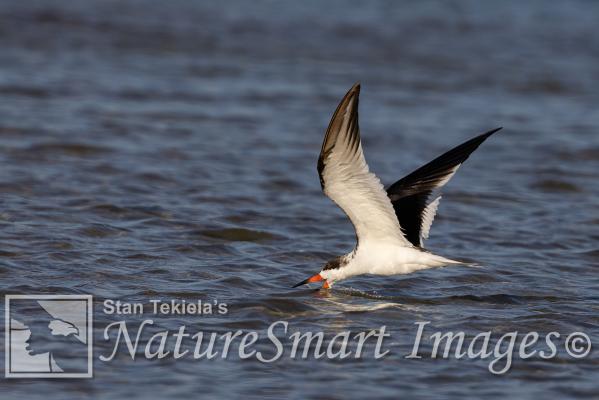View all of the titles in the
NatureSmart Bookstore

by Stan Tekiela
© NatureSmart
May 13, 2023
When it comes to birds, it is all about the bill. Ya, you know, the bill or beak. The bill of a bird is what really makes the birds unique. It was Darwin who noticed that the finches he saw on the Galapagos Islands in 1831-36, had different shaped and size bills that corresponded with the diet of each bird. Nearly two hundred years later, we still use the size and shape of a bird’s bill/beak as a way to group or classify birds.
All of this was rushing through my head one day while I stood in shin deep salt water off the coast of Florida. While leading a photo tour to capture images of birds in the sunshine state, we had stopped at a wonderful beach that had several very large tidal pools. These tide pools are isolated pockets of seawater found in the ocean’s intertidal zone. When the tide comes in the pools fill and recharge with lots of ocean critters such as Star-fish (now called Sea Star) and small fish, crustations and so much more. When the tide goes out, the pool drains.
I am always attracted to tidal pools because they draw so much wildlife. So, we were walking around in ankle deep water enjoying the sunshine and warm temperatures hoping to capture some images of some birds. In particular we were hoping to see some Black Skimmers (Rynchops niger).
The Black Skimmer is a tern-like seabird with an incredibly large, red and black bill that is as thin as a knife blade. They are closely related to Terns and Gulls but are in their own Genus. In addition, the lower bill is significantly longer than the upper bill. This would be exactly opposite of all other birds. In general, the upper bill is almost always larger than the lower bill in other birds.
These are large birds with nearly a 4-foot wingspan and are about 20 inches from head to tail. The males are noticeably larger than the females. You never see just one Black Skimmer by itself. They are always flying in flocks or resting on the beach in small groups. They also nest in small colonies of dozens of pairs. It is estimated the population of the Black Skimmer is 90,000 to 100,000 in the U.S. and the population is decreasing over the past 50 years as it is for so many other birds.
But it’s the bill on this bird that is so remarkable and worth spending some time addressing. The Black Skimmer bill is three to four inches long. While having a long bill isn’t uncommon in the bird world, it is the narrowness of the bill that is so astounding. Once you see how these birds hunt for small fish, you will realize while the lower bill is longer than the upper bill and while the bill is as narrow as a knife.
To catch small fish, the Black Skimmer flies just above the waters surface and using its long narrow lower bill, it “skims” the water. The long lower bill slices through the water as the bird is flying. When the bird comes in contact with a fish the lower bill snaps shut, and the bird has its dinner. If they had a normal sized and width bill this kind of high speed “fishing” wouldn’t be possible.
We spent three days wondering around the tide pools hoping some Black Skimmers would show up. We had nearly given up when late in the evening, just before sunset, a small group of less than 10 skimmers showed up. They were flying low across the tide pool and heading for a shallow sandbar, to join many other shorebirds that were settling in for the night when we spotted the skimmers.
Luckily a few of the skimmers started fishing and we were able to capture just a few images of these amazing birds “skimming” right before the sunset and before they settled in for the night. So next time you see a bird try to note the size and shape of the bird’s bill. It is the key to how they feed and ultimately survive. Until next time…
Stan Tekiela is an author / naturalist and wildlife photographer who travels the U.S. to study and capture images of wildlife. He can be followed on www.instagram.com, www.facebook.com and twitter.com. He can be contacted via his web page at www.naturesmart.com.
The nationally syndicated NatureSmart Column appears in over 25 cities spanning 7 states: Minnesota, Wisconsin, Michigan, Illinois, Ohio, New York and Pennsylvania. It is a bi-weekly column circulated to over 750,000 readers.
Horned Lark
The overall population of ground nesting birds is steadily going down. Here in North America, we have hundreds of bird species who nest directly on the ground. Prairie birds such as Eastern and Western Meadowlarks are a good example. If you are older than 50 you most likely remember hearing...
Sharp-tailed Grouse
The rights of spring come in many different forms, shapes, colors, and patterns. But the end goal is always exactly the same—reproduction. In nature, everything can be boiled down to one of two things, finding food to survive and mating for reproduction. It’s as simple as...
Greater Prairie Chicken
I am not a stranger to getting up at O’ dark thirty, to be able to get out and capture some images of wildlife. Over the past 40 years I would say it is definitely in the hundreds if not thousands of times I’ve dragged myself out of bed so early. So, last week when the alarm went off...
Marsh Rabbit
For me, I enjoy all aspects of nature, not just birds. I find all of nature fascinating and that is what keeps me interested. So, while leading a photo tour to Florida recently I was so excited to see a crazy cool critter that isn’t what you expect when you see it. A true rule...
Each year, during June and July, Stan Tekiela offers two world-class wildlife photography tours. Here's your chance to learn some tricks of the trade from a top professional.
View all of the titles in the
NatureSmart Bookstore
Check out Stan's latest photos at
NatureSmart Wildlife Images
Do you have any interesting wildlife in your backyard? Any nesting birds, deer, turkeys, reptiles, amphibians, or other unique wildlife? Or maybe a fox or coyote den?
If so, contact Stan at stan@naturesmart.com with your backyard wildlife. If he can get a good photo of the subject, he will send you a print of the photo to hang on your wall.
Order Prints and posters of Stan's photos at
» Prints & Posters
Hear Stan on radio stations all across the Midwest.
» More Info

When he's out in the field, Stan relies on his Vortex Razor binoculars and Vortex Razor spotting scope to help find the subjects for his award winning wildlife photography.

For thirty years, professional wildlife photographer Stan Tekiela has counted on Hunt's Photo and Video to provide him with professional photography equipment.
From tripods to camera bodies and lenses, Hunt's has been Stan's place for everything that he needs. Personal service and prompt shipping means Stan can count on Hunt's to support his professional wildlife photography career.


Professional Wildlife Photographer Stan Tekiela always uses Feeder Fresh in his seed feeders to help keep the feeders and food dry, clean and mold free.
He also uses Feeder Fresh Nectar Defender in all of his hummingbird feeders. It safely keeps nectar fresh longer.